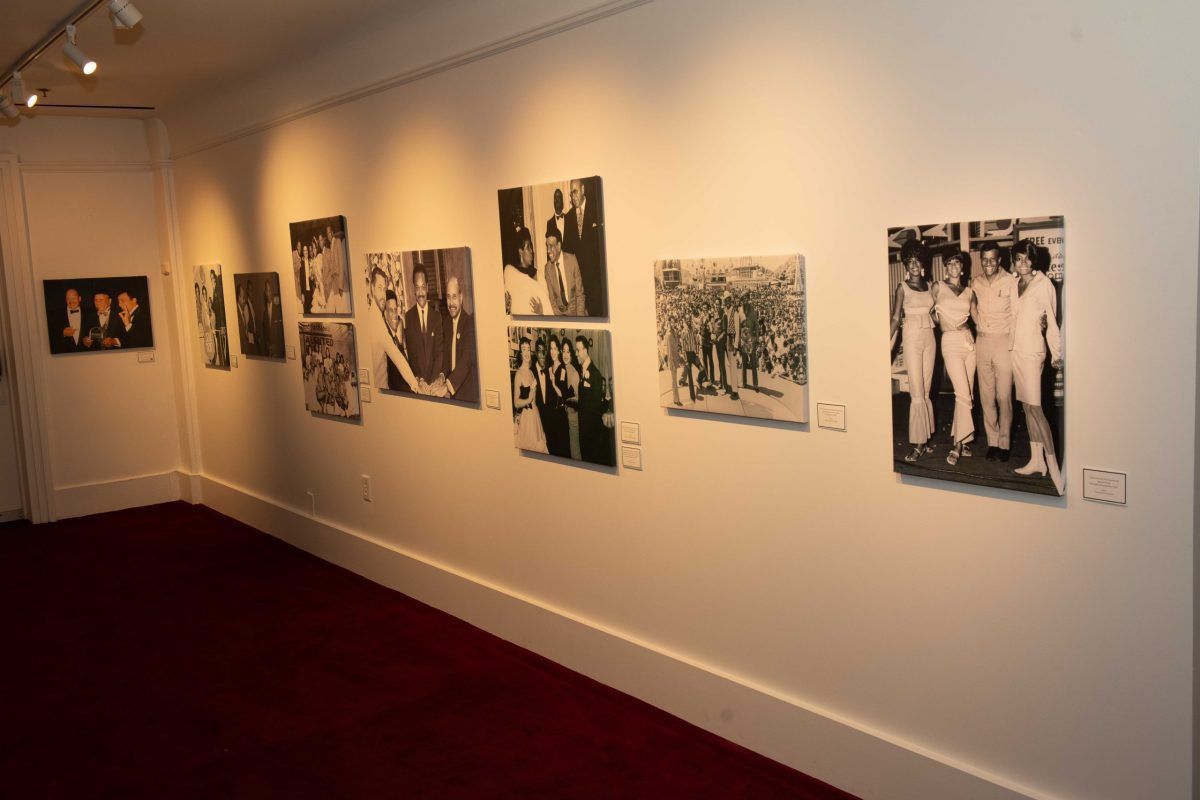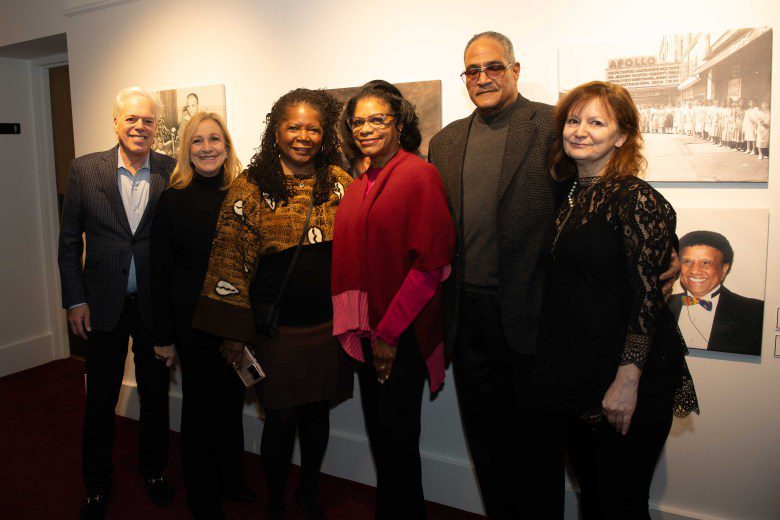
A Visual Journey: The Legacy of a Black Radio Trailblazer
“The House That Jack Built: Hal Jackson, the Godfather of Black Radio – A Photo Retrospective” opened on Feb. 19 in the Sandy Bennett Gallery at BergenPAC, 30 Van Brunt St., Englewood, NJ. Credit: Photo KENTHEPHOTOGRAPHER
In 1939, Harold “Hal” Jackson was about 24 years old when he entered a Washington, D.C., radio station and said he wanted to be on the air.
Jackson was told no “n-word” would ever be on that radio station. In 2008, when he turned 93, he recalled that incident to NPR as he reflected on his storied career.
Among several firsts, Jackson is credited with being the first Black on network radio.
And here in Bergen County, people can see Jackson making history via a visual journey exhibit curated by Debi B. Jackson, the late icon’s wife and a radio legend in her own right.
“The House That Jack Built: Hal Jackson, the Godfather of Black Radio – A Photo Retrospective” opened on Feb. 19 in the Sandy Bennett Gallery at BergenPAC, 30 Van Brunt St., Englewood.
 Charles Campbell, Michelle Campbell, Debi Jackson, Valerie Huttle, Mayor Frank Huttle and Helene Cohen.
Photos in the exhibit include those taken by Debi B. Jackson, whose photography was exhibited at the Adam Clayton Powell, Jr. State Office Building in NYC – with proceeds going to the (Youth Development Foundation Inc.)
All pictures are taken by photographers who capture images of Jackson with peers and other luminaries.
Throughout the 1940s, Jackson hosted what may arguably be considered his signature show, “The House That Jack Built,” for WOOK in D.C. In it, he combined his love of jazz—a musical form he was fond of—and other popular music with intellectual subject matter discussed with experts and famous figures of the day.
Jackson told NPR that each room of this house was supposed to have something distinctly appealing to someone.
“Don’t worry and don’t even have a sneeze,” Jackson says in one intro. “In ‘The House That Jack Built,’ everything is cozy and warm …”
Jackson provided his audience with a kind of safe space.
While this extended to everyone who could hear his voice, it has to be noted came before the height of the Civil Rights movement, when discriminatory “Jim Crow” laws loomed over the South and well before the Civil Rights Act of 1964 outlawed discrimination based on race, sex, color, religion and national origin.
From those early days paved with buying air time, to being one of the first Black radio sports announcers through “The House That Jack Built,” Jackson made his way to New York City just ahead of the 1950s.
Jackson was hired by WLIB, and he reportedly had as many as four million listeners tuning in to his three daily shows on three different NYC-area radio stations.
The Civil Rights era of the 1960s lost ground with the assassinations of Malcolm X, Martin Luther King Jr., John F. Kennedy and Bobby Kennedy (along with, arguably, the spiritual assassinations of figures like Fannie Lou Hamer, whose death in the 1970s was preceded by two nervous breakdowns).
In 1971, Jackson and Percy Sutton co-founded the Inner City Broadcasting Corporation, making them the first Black owners-operators of a radio station in NYC. Their company would even buy WLIB, bringing Jackson a unique full-circle moment.
He maneuvered into ownership of a piece of the prominent pop culture mediums that prospered on Black talent, and doing this continues to be particularly elusive for Black Americans.
According to a 2023 NPR report, only 4% of media in the U.S. is Black-owned.
Jackson’s other accomplishments include being the first Black person to be inducted into the National Association of Broadcasters Hall of Fame in 1990, almost 20 years after he and Sutton became the first Black owners-operators of a radio station.
Jackson passed away in 2012 at the age of 96.
Anyone who sees a show at BergenPAC should also see “The House That Jack Built: Hal Jackson, the Godfather of Black Radio—A Photo Retrospective” on the mezzanine level during daily box office hours or show evenings.
Appointments can also be made to see “The House That Jack Built.” For more information, email hcohen@bergenpac.org or visit https://www.bergenpac.org/sandy-bennett-art-gallery.
Charles Campbell, Michelle Campbell, Debi Jackson, Valerie Huttle, Mayor Frank Huttle and Helene Cohen.
Photos in the exhibit include those taken by Debi B. Jackson, whose photography was exhibited at the Adam Clayton Powell, Jr. State Office Building in NYC – with proceeds going to the (Youth Development Foundation Inc.)
All pictures are taken by photographers who capture images of Jackson with peers and other luminaries.
Throughout the 1940s, Jackson hosted what may arguably be considered his signature show, “The House That Jack Built,” for WOOK in D.C. In it, he combined his love of jazz—a musical form he was fond of—and other popular music with intellectual subject matter discussed with experts and famous figures of the day.
Jackson told NPR that each room of this house was supposed to have something distinctly appealing to someone.
“Don’t worry and don’t even have a sneeze,” Jackson says in one intro. “In ‘The House That Jack Built,’ everything is cozy and warm …”
Jackson provided his audience with a kind of safe space.
While this extended to everyone who could hear his voice, it has to be noted came before the height of the Civil Rights movement, when discriminatory “Jim Crow” laws loomed over the South and well before the Civil Rights Act of 1964 outlawed discrimination based on race, sex, color, religion and national origin.
From those early days paved with buying air time, to being one of the first Black radio sports announcers through “The House That Jack Built,” Jackson made his way to New York City just ahead of the 1950s.
Jackson was hired by WLIB, and he reportedly had as many as four million listeners tuning in to his three daily shows on three different NYC-area radio stations.
The Civil Rights era of the 1960s lost ground with the assassinations of Malcolm X, Martin Luther King Jr., John F. Kennedy and Bobby Kennedy (along with, arguably, the spiritual assassinations of figures like Fannie Lou Hamer, whose death in the 1970s was preceded by two nervous breakdowns).
In 1971, Jackson and Percy Sutton co-founded the Inner City Broadcasting Corporation, making them the first Black owners-operators of a radio station in NYC. Their company would even buy WLIB, bringing Jackson a unique full-circle moment.
He maneuvered into ownership of a piece of the prominent pop culture mediums that prospered on Black talent, and doing this continues to be particularly elusive for Black Americans.
According to a 2023 NPR report, only 4% of media in the U.S. is Black-owned.
Jackson’s other accomplishments include being the first Black person to be inducted into the National Association of Broadcasters Hall of Fame in 1990, almost 20 years after he and Sutton became the first Black owners-operators of a radio station.
Jackson passed away in 2012 at the age of 96.
Anyone who sees a show at BergenPAC should also see “The House That Jack Built: Hal Jackson, the Godfather of Black Radio—A Photo Retrospective” on the mezzanine level during daily box office hours or show evenings.
Appointments can also be made to see “The House That Jack Built.” For more information, email hcohen@bergenpac.org or visit https://www.bergenpac.org/sandy-bennett-art-gallery.

Content retrieved from: https://njurbannews.com/2025/03/05/a-visual-journey-the-legacy-of-a-black-radio-trailblazer/ .